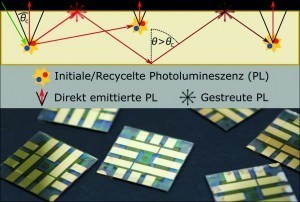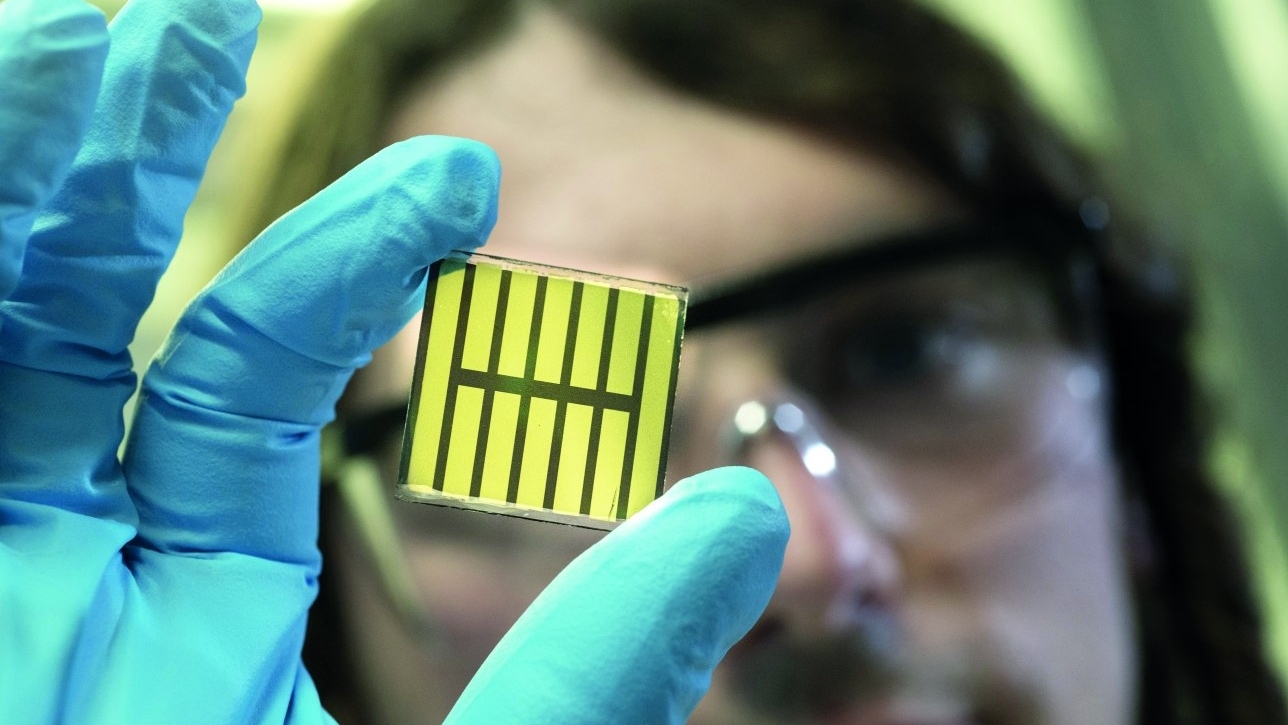Metal halide perovskites are considered to be particularly promising materials for next-generation solar cells. A new model for determining the photoluminescence quantum yield has been developed for this purpose.
Metal-halide perovskites are considered particularly promising materials for next-generation solar cells. For this purpose, a new model for determining the photoluminescence quantum yield was developed.
How suitable a semiconductor is for use in photovoltaics can be determined, among other things, by the so-called photoluminescence quantum yield. Researchers at the Karlsruhe Institute of Technology (KIT) have developed a new model with which the photoluminescence quantum yield of perovskite layers can be precisely determined for the first time. They report on this in the journal Matter [1].
Photovoltaics make a significant contribution to a sustainable energy supply. The material used is decisive for the efficiency of solar cells, which convert light energy directly into electrical energy. Metal halide perovskites are regarded as particularly promising materials for next-generation solar cells. The semiconductors owe their name to the special perovskite crystal structure. A significant increase in efficiency has been achieved with them in recent years: Perovskite solar cells have now achieved an efficiency of up to 25.5 % - and are therefore at the upper end of what can be achieved with currently market-dominating silicon solar cells without concentrator technology [2].  The proportion of so-called photon recycling, the re-emission of reabsorbed photons, plays an important role in calculating the photoluminescence quantum yield
The proportion of so-called photon recycling, the re-emission of reabsorbed photons, plays an important role in calculating the photoluminescence quantum yield
The efficiency that can theoretically be achieved with perovskite solar cells is around 30.5 %. In addition, the raw materials required for perovskite solar cells are available in abundance - the solar cells can be produced easily and cheaply and used in a variety of ways.
The optoelectronic quality of perovskite semiconductors must continue to improve in order to come close to the theoretically achievable efficiency mentioned above. In principle, materials suitable for photovoltaics should not only absorb light, but also re-emit it efficiently - a process known as photoluminescence.
The associated measurement parameter, known as photoluminescence quantum yield, is therefore ideally suited to determining the quality of perovskite semiconductors. Researchers at the Institute of Microstructure Technology (IMT) and the Light Technology Institute (LTI) at KIT [3], together with scientists from the Centre for Advanced Materials (CAM) at Heidelberg University [4] and Dresden University of Technology [5], have now developed a new model with which the photoluminescence quantum yield of perovskite layers can be reliably and precisely determined for the first time.
More optimization potential than assumed
"Our model makes it possible to determine the photoluminescence quantum yield under solar irradiation conditions more precisely than before," explains Dr. Paul Faßl from the IMT at KIT. "It depends on the photon recycling, i.e. the proportion of photons emitted by the perovskite that is reabsorbed and re-emitted within the thin layers." The researchers applied their model to methylammonium lead triiodide (CH3NH3PbI3), one of the perovskites with the highest photoluminescence quantum yield. This was previously estimated to be around 90 %, but according to the model calculations it is around 78 %. As the scientists explain, the previous estimates did not adequately take into account the effect of light scattering and therefore underestimated the probability of photons - the quanta of light energy - escaping from the layer before they are reabsorbed.
"Our results show that the potential for optimizing these materials is significantly higher than previously assumed," says Dr. Ulrich W. Paetzold, head of the Advanced Optics and Materials for Next Generation Photovoltaics group at KIT's IMT. The research team provides an open-source application that can be used to calculate the photoluminescence quantum yield of various perovskite materials based on their model.
References:
[1] Original publication: Paul Fassl; Vincent Lami; Felix J. Berger; Lukas M. Falk; Jana Zaumseil; Bryce S. Richards; Ian A. Howard; Yana Vaynzof; Ulrich W. Paetzold: Revealing the internal luminescence quantum efficiency of perovskite films via accurate quantification of photon recycling, Matter, Cell Press, 2021, DOI: 10.1016/j.matt.2021.01.019. https://authors.elsevier.com/a/1cbg49CyxcxO47
[2] https://de.wikipedia.org/wiki/Solarzelle
[3] Details on the KIT Center for Energy: http://www.energie.kit.edu
[4] https://www.cam.uni-heidelberg.de/
[5] https://tu-dresden.de/mn/physik/iap/hlp/forschung


